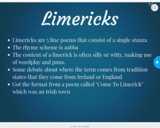
Teaching about and writing Limericks with students in a nearpod
- Subject:
- Arts and Humanities
- Literature
- Material Type:
- Activity/Lab
- Date Added:
- 05/18/2021

Teaching about and writing Limericks with students in a nearpod
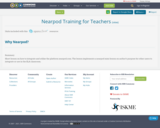
Short lesson on how to integrate and utilize the platform nearpod.com. The lesson implements a nearpod mini-lesson on author's purpose for other users to integrate or use in the ELA classroom.

After more than 30 years in prison and an historic election that for the first time in the nation's history included all citizens regardless of race, Nelson Rolihlahla Mandela became President of the Republic of South Africa on May 10, 1994. This Teacher's Guide includes resources for teaching about the brutality of apartheid, the resilience of the nation's people, the leadership of Nelson Mandela, and primary source materials that will inform discussion about the country's emergence in the world.

This course addresses the place of contemporary queer identities in French discourse and discusses the new generation of queer authors and their principal concerns. Class discussions and readings will introduce students to the main classical references of queer subcultures, from Proust and Vivien to Hocquenghem and Wittig. Throughout the course, students will examines current debates on post-colonial and globalized queer identities through essays, songs, movies, and novels. Authors covered include Didier Eribon, Anne Garréta, Abdellah Taïa, Anne Scott, and Nina Bouraoui. This class is taught in French.
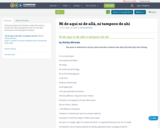
This poem depicts the identity conflict that exist in faculty who have immigrated to the U.S. and their interactions with immigrant students.

This poems portrays the identity conflict within the faculty and students.

In the United States, the nineteenth century was a time of tremendous growth and change. The new nation experienced a shift from a farming economy to an industrial one, major westward expansion, displacement of native peoples, rapid advances in technology and transportation, and a civil war. In this lesson, works of art from the nineteenth century are paired with written documents, including literary selections, a letter, and a speech. As budding historians, students can use these primary sources from the nineteenth century to reconstruct the influence of technology, geography, economics, and politics on daily life.
In this lesson students will: Learn about daily life in the United States in the 1800s through visual art and literature; Understand some of the ways in which nineteenth-century life was affected by technology, geography, economics, and politics; Apply critical-thinking skills to consider the various choices artists and writers have made in depicting daily life around them; Make personal connections to the nineteenth century by placing themselves in the contexts of works of art and readings.

The contents of this website are to help the students of COD's Non-Western Literature course to apply theoretical and contextual knowledge to the texts we read. Also linked from Literature @ College of DuPage.

This course addresses the philosophical question of what a non-violent life entails. It investigates its ethical dimensions and challenges, and considers whether we can derive a comprehensive moral theory from the principle of non-violence. In addition, it discusses the issues of lying, the duty to forgive, non-violent communication, the ethics of our relationship to anger, the possibility of loving enemies, and the ethics of punishment and rehabilitation. Readings are included from primary exponents of non-violence, such as Tolstoy, Gandhi, and King.
This course is part of the Experimental Study Group at MIT.

The course offers an analysis of the keen interest shown by France and the French in North American cultures since the 18th century. Not only did France contribute to the construction of both Canadian and American nations, but it has also constantly delineated its identity by way of praising or criticizing North American cultures. Using materials drawn from literature, comics, TV shows, and series as well as political debates, the course will historically trace this ambivalent relation exploring various themes such as liberalism, entertainment and the media, trade and cultural goods, transatlantic intellectual encounters, and translation.
The course is taught entirely in French.
About the instructor: Bruno Perreau is the Cynthia L. Reed Associate Professor of French Studies at MIT. He is also an Affiliate Faculty at the Center for European Studies, Harvard. Perreau recently published The Politics of Adoption: Gender and the Making of French Citizenship (MIT Press, 2014), Queer Theory: The French Response (Stanford University Press, 2016), Les Défis de la République (ed. with Joan W. Scott, Presses de Sciences Po, 2017), Qui a peur de la théorie queer ? (Presses de Sciences Po, 2018), Sphères d’injustice. Pour un universalisme minoritaire (La Découverte, 2023).

Short Description:
North and South (1854) is a social novel by English writer Elizabeth Gaskell. The novel follows Margaret Hale as she is forced to leave her home in the tranquil, rural south and settle with her parents in the fictional industrial town of Milton in the north of England. She witnesses the consequences of the Industrial Revolution and the first strikes between employers and workers.
Long Description:
North and South (1854) is a social novel by English writer Elizabeth Gaskell. The novel follows Margaret Hale as she is forced to leave her home in the tranquil, rural south and settle with her parents in the fictional industrial town of Milton in the north of England. She witnesses the consequences of the Industrial Revolution and the first strikes between employers and workers.
Word Count: 181971
(Note: This resource's metadata has been created automatically as part of a bulk import process by reformatting and/or combining the information that the author initially provided. As a result, there may be errors in formatting.)
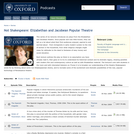
This series of six lectures introduces six plays from the Elizabethan and Jacobean theatre. Once popular and now little-known, they can tell us a lot about what their first audiences enjoyed, aspired to and worried about - from immigrants in early modern London to the role of women in the household, from what religious changes might mean for attitudes to the dead to fantasies of easy money and social elevation. Each lecture outlines the play so there is no assumption you have already read it, then goes on to try to understand its historical context and its dramatic legacy, drawing parallels with modern film and contemporary culture as well as with Elizabethan material. The lecturer's aim with students in the room and with interested listeners on iTunes U is to broaden our understanding of the theatre Shakespeare wrote for by thinking about some non-Shakespearean drama, and to recreate some of the excitement and dramatic possibilities of the new, popular technology of Renaissance theatre.
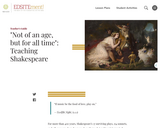
For more than 400 years, Shakespeare's 37 surviving plays, 154 sonnets, and other poems have been read, performed, taught, reinterpreted, and enjoyed the world over. This Teacher's Guide includes ideas for bringing the Bard and pop culture together, along with how performers around the world have infused their respective local histories and cultures into these works.

Group Novel Analysis Unit:Students work through and discuss a novel of significant literary merit in five sessions before selecting a topic upon which to compose an analytical essay.

This resource provides lecture notes and writing assignments for the study of a novel - in this case, Aldous Huxley's Brave New World. These notes and assignments, however, can be adapted and applied to practically any novel. Unless otherwise noted, this resource is licensed under CC BY-NC-SA.
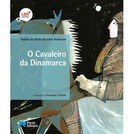
Verificação de leitura-Abrir o link e realizar a atividadehttps://docs.google.com/forms/d/1KluyhSIrVB3kdlDLEStP6guUGsY1zFY01aJ6QsBBBk4/edit
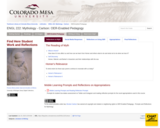
This resource includes prompts for student social media posts and reading reflections as well as a curated collection of student responses to readings and student observations on open pedagogy collaborations in the course.
The resource is embedded in a research guide for a Mythology course at Colorado Mesa University.

Lars Sudmann has a large experience in coaching leaders and presenting himself as series of specialized presentations (e.g. TedX). He shares with us his tips for efficient oral and written presentations.

André Crettenand est directeur de l'information chez TV5 Monde. Il nous explique les choix stratégiques en matière de communication et de marketing. Ces vidéos proposent un entretien pédagogisé avec des acteurs du monde de la communication d'entreprise, au sens large : commerce, finance, ONG, médias d'information... Chaque entretien comprend des témoignages originaux, des concepts mis en exergue ainsi qu'un sous-titrage permettant de donner l'accès à des non-natifs.
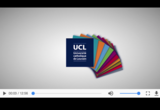
Le discours commercial à l'heure numérique. Anne-Catherine De Neve, chargée de communication chez Crédal.
Ces vidéos proposent un entretien pédagogisé avec des acteurs du monde de la communication d'entreprise, au sens large : commerce, finance, ONG, médias d'information... Chaque entretien comprend des témoignages originaux, des concepts mis en exergue ainsi qu'un sous-titrage permettant de donner l'accès à des non-natifs.